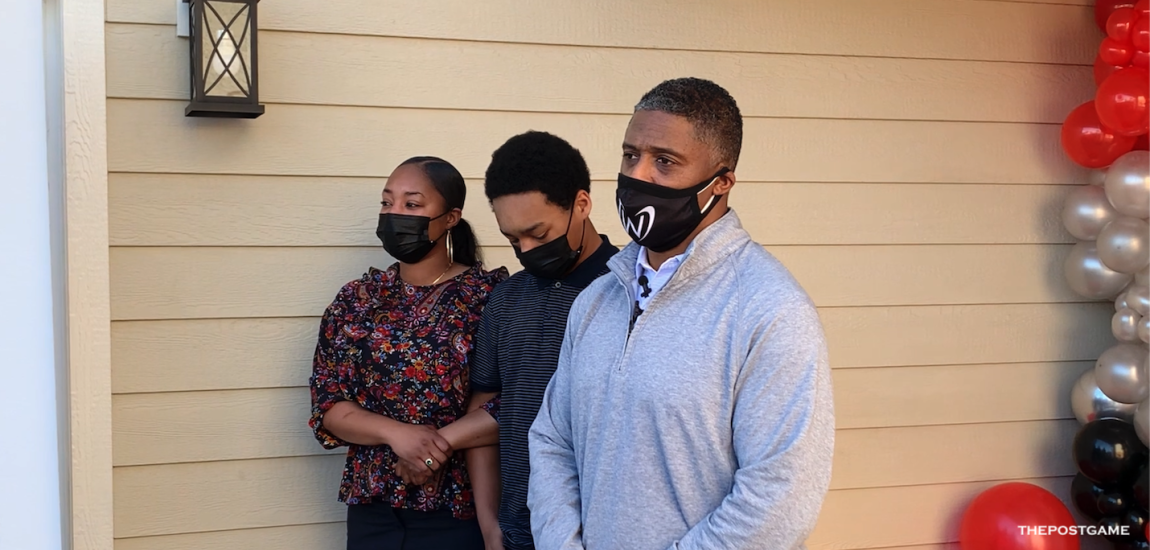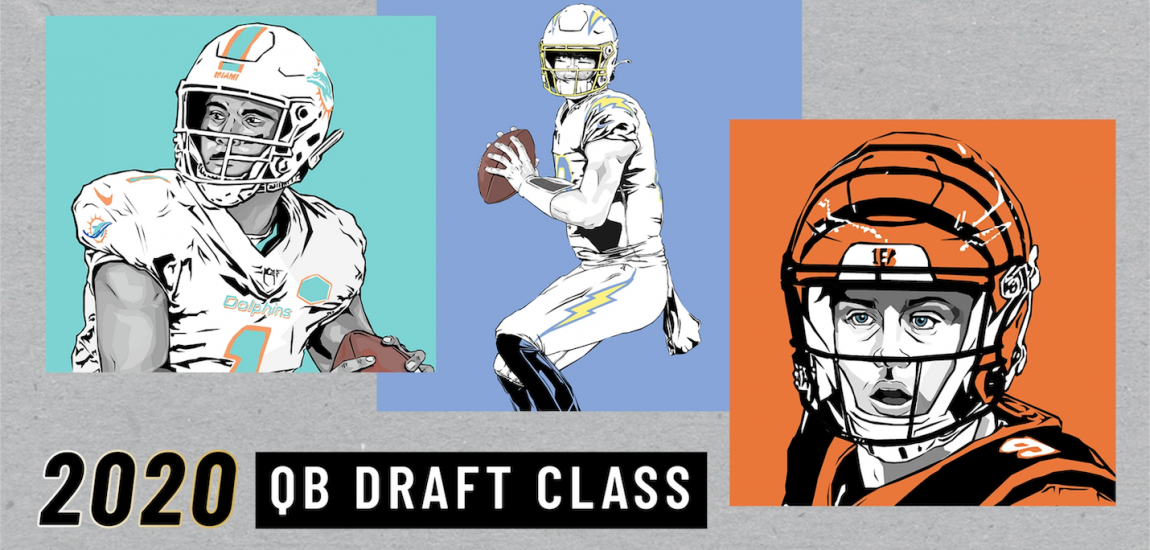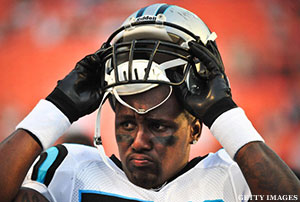
One Knee. Three successive torn ACLs. In 23 months.
Thomas Davis' most recent ligament injury occurred during Week 2 of the 2011 NFL season. While tackling Packers running back James Starks, the Panthers linebacker planted his right foot into the Bank of America Stadium turf. Panthers defensive tackle Terrell McClain collided into Davis' leg. The hit torqued his protective brace-supported right knee awkwardly.
After his knee swelled up over night, and the next day's MRI confirmed his worst fears, Davis was devastated.
"I thought … my career was over," he said. "It was like, ‘OK, this is it. I'm done. I did all I could. I gave it my best effort.'"
But the 14th overall pick in the 2005 draft talked to his wife, Kelly, and team chaplain Michael Bunkley.
They discussed how good he felt and how well he played -- despite two reconstructive surgeries -- before his injury against the Packers. He had regained his 4.4 speed in the 40 and his starting linebacker position, collecting 12 tackles in the 2011 season opener. Davis also thought about how much he loved football.
Then he met with Panthers owner Jerry Richardson, general manager Marty Hurney and head coach Ron Rivera, who said they would give him an opportunity to remain on the team in 2012.
"That was the only motivation I needed from that point on," Davis said. "That drove me."
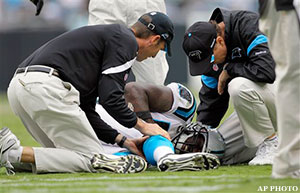
He rehabilitated relentlessly, pushing through 10-hour days and telling the Panthers head athletic trainer, Ryan Vermillion, "We're going to make history." For 10 months he worked daily on his range of motion, strength and agility from 8 a.m. to 2 p.m. at the Panthers facility -- followed by additional at-home rehab sessions well into the night.
"That young man worked his tail off to get back to where he is right now," Panthers linebackers coach Warren Belin said. "He's an inspiration."
Completing one of the most impressive medical recoveries ever in sports, Davis played in Week 1 of the 2012 season, becoming the first player to successfully resume his NFL career after three ACL surgeries on the same leg.
Although Davis, 29, recorded at least 88 tackles a season while starting 46 games from 2006 to 2008, the Panthers did not want to pay an $8 million option bonus -- due in March -- to a player recovering from his third knee injury.
They restructured his contract, declining the option and dropping his base salary from $2.25 million to $700,000, the league minimum.
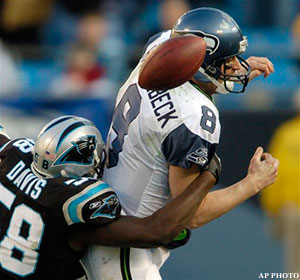
"The feeling that I have and the love that I have for this game," Davis said, "I honestly would go out and play this game (for) free."
He returned to the game he loves, receiving his first game action in NBC's nationally televised Sunday night contest against the Jets during Week 3 of the preseason.
On a 3rd-and-7 in the first quarter -- his very first play of 2012 -- Davis blitzed on a delay, sneaking through a crevice in the offensive line to sack Jets QB Mark Sanchez.
"It was a big boost on our sidelines," Belin said.
Davis returned to regular season action for Week 1. Still one of the fastest defenders on the team, he typically plays 20 to 25 snaps a game as a weakside linebacker in sub packages and on special teams.
Davis graded out particularly well in the Panthers' 35-27 victory against the Saints in Week 2 when his responsibilities included covering tight end Jimmy Graham and running back Darren Sproles.
Earning the start against the Seahawks and collecting six tackles in Week 5, he further showed the completeness of his recovery.
"My knee is feeling great," he said. "I'm 100 percent."
During the grind of the season, though, no NFL player is totally healthy. The trainers monitor the litany of injuries for which each player needs care. But Davis' knee does not even appear on the Panthers' treatment log.
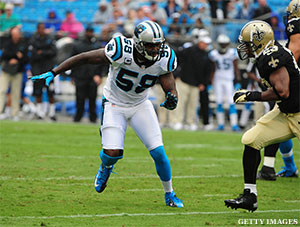
"It's not even a factor anymore," Vermillion said.
It would be unrealistic to expect all athletes -- let alone weekend warriors -- to return so effectively following three anterior cruciate ligament surgeries, but Davis demonstrated how much medical technology has advanced.
"Years ago ACLs did end careers," Vermillion said. "In this day and age, we're not seeing that anymore. Guys are able to come back within a year."
Not only are athletes better conditioned than ever before, surgery and rehabilitation have improved greatly. Doctors can more precisely place the implanted patellar tendon or hamstring graft into the area of the ruptured ACL, resulting in earlier weight bearing, stimulation of quadriceps and hamstring muscles and range of motion. By going into full extension and flexion much sooner and with less fear of stressing the graft, patients have a better chance of regaining the movement they had before injury.
Since doctors began performing knee reconstructions more than 30 years ago, post-operative treatment has evolved from casting the leg from hip to toe in the mid-1980s to mandating a long brace and no weight bearing in the mid-1990s. Now right out of surgery, patients wear a small brace and bear weight on their surgically repaired leg as tolerated. The time on crutches has gone from weeks to seven to 10 days.
What was once a three-hour surgery, necessitating days in the hospital, now is an outpatient procedure, which takes about 90 minutes. Doctors used to create a six-inch to eight-inch incision. With some of the operation performed arthroscopically, it requires just a two-inch incision, meaning less trauma and pain and a better recovery.
Davis had set a goal of playing all 16 games in 2012.
He has played in every contest except for Week 3's Thursday Night Football game against the Giants, and Davis said he could have played if he had a normal week's recovery time for his hamstring to heal.
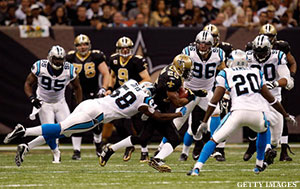
He also missed most of the preseason after straining his right calf during the second training camp practice. Both ailments are likely a result of pushing his rehab too hard.
"It is related to the knee," Vermillion said. "It's gotta be."
But those setbacks are minor, considering the multitude and nearly unprecedented number of ACL injuries he suffered.
"The second tear is like being hit by lightning twice," said one orthopedic surgeon. "The third one is just extraordinary."
During the fourth quarter of a Week 9 game vs. the Saints in the 2009 season, Davis, who was battling a pulled hamstring, jammed Saints receiver Devery Henderson to re-route him. Davis went to plant, and his right knee gave out.
After doctors implanted a graft of his hamstring tendon to replace the torn ACL, Davis mended quickly.
"Everything was going great," Davis said. "I got my strength back probably five-and-half, six months into recovery."
Shortly thereafter, though, he was doing a basic hip twist drill during 2010 OTAs and tore up his knee again. This time doctors used the patellar tendon graft from his right knee to reconstruct his leg.
After he ruptured his ACL during Week 2 of the 2011 season, Dr. James Andrews did not have the option to implant his right hamstring tendon or right patellar tendon -- because both had ruptured during the previous injuries.
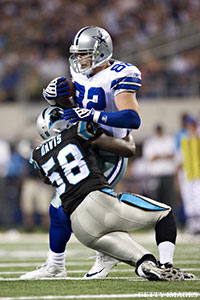
The famed orthopedic surgeon did not want to use a cadaver's tendon, so he took the graft from Davis' left patellar tendon, meaning the linebacker had to have surgery on and rehabilitate both knees and making his recovery all the more impressive.
Combining that with his other two recoveries from knee surgery, Davis rehabbed for more than 600 days.
"He has never ever backed down from the challenges of getting it done -- the first time, the second time and even the third time," Vermillion said. "His attitude has been what has been phenomenal for him. It got him through these hard times."
Were these hard times, though, caused by something biomechanically in Davis that made him more prone to ACL tears?
Female athletes suffer ACL injuries more frequently than males because they have wider hips, creating a greater Q angle (where the thigh bone meets the shin). In addition women and others who suffered frequent ligament tears sometimes have a more narrow intercondylar notch (tunnel) at the bottom of the femur (thigh bone).
"I don't see anything that predisposed him." Vermillion said. "A lot of Thomas' thing just had to do with bad luck ... It's just the nature of this game and the toughness of this game that really got him. "
And Davis likely has not finished paying the price for playing the brutal game that he loves. Expect him to suffer knee arthritis down the road.
"If he lives long enough," the orthopedic surgeon said, "the odds are he'll have a (knee) replacement."
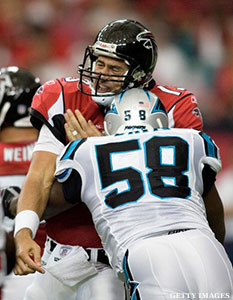
Aware of what to expect at each post-operative stage, Davis has become an expert in recovering from ACL injuries.
"I know how tough it is," Davis said. "Nobody else can really relate."
That's why he became a valuable mentor last year, helping other injured Panthers, including receiver David Gettis and offensive lineman Zach Williams, who also tore their ACLs.
Fellow linebacker Jon Beason, selected in the first round two years after Davis, ruptured his left Achilles tendon during Week 1 of 2011.
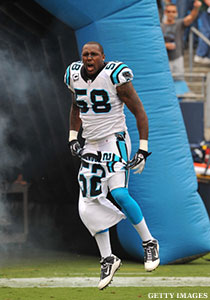
Beason and Davis helped each other as they came back from season-ending injuries, providing motivation when they did not feel like going through the drudgery of another long rehab session.
"We're like brothers, man. I know you hear a lot of other guys say that, but we truly are," Davis said. "Whenever we get into a setting where it becomes competitive, we push each other."
Davis' counsel was not restricted to players on his own team. He reached out to Giants cornerback Terrell Thomas, who tore his ACL while covering receiver Domenik Hixon during a passing drill in a late July training camp practice. It was the third time Thomas had torn his right ACL.
Davis called him to encourage him, telling Thomas he could "lean on" him and ask any questions.
"I just know how hard the situation was for me and I know how people can look down upon a guy that has been hurt three times," Davis said. "Also I want my play to encourage the Giants that it can happen. It is possible for a guy to not only play -- but play well -- after tearing their knee three times."
Maybe the cornerback can follow the path Davis trail blazed on the way to his groundbreaking recovery.
"I definitely take pride in it," Davis said. "A lot of hard work had to go into me getting to this point, and I'm just excited to be where I am right now."





